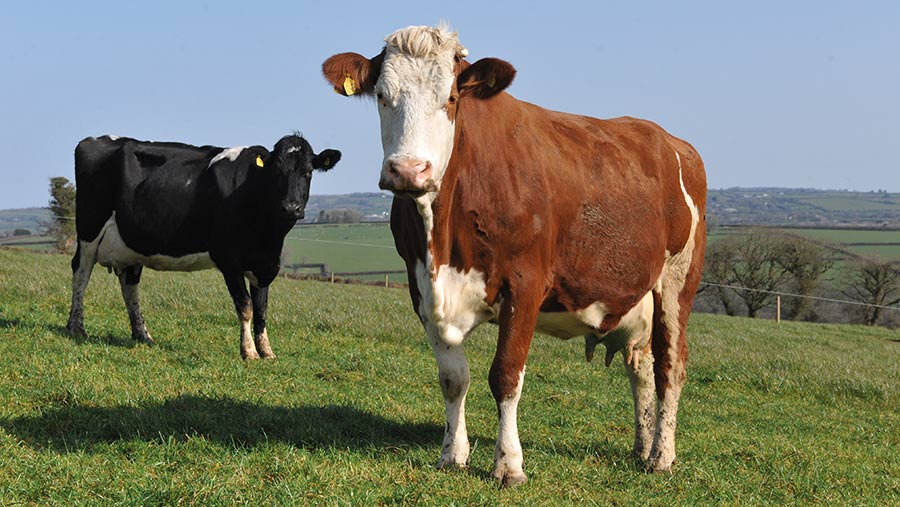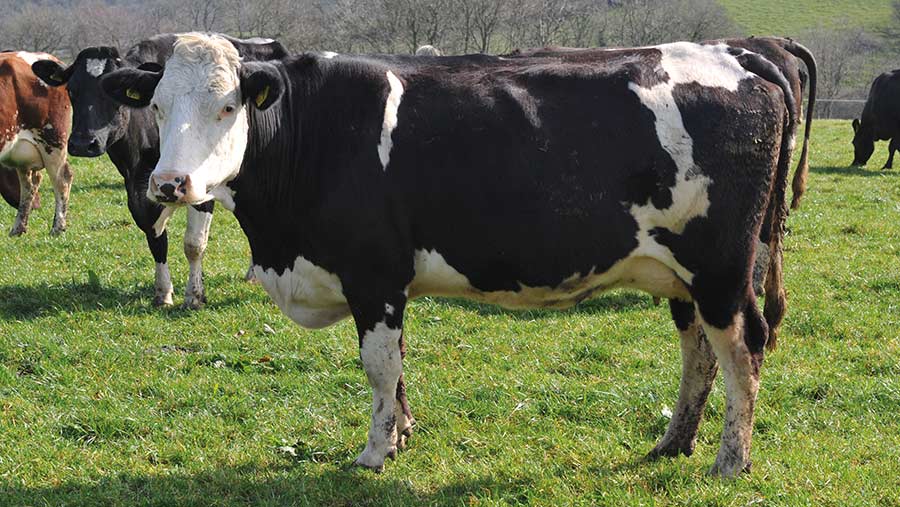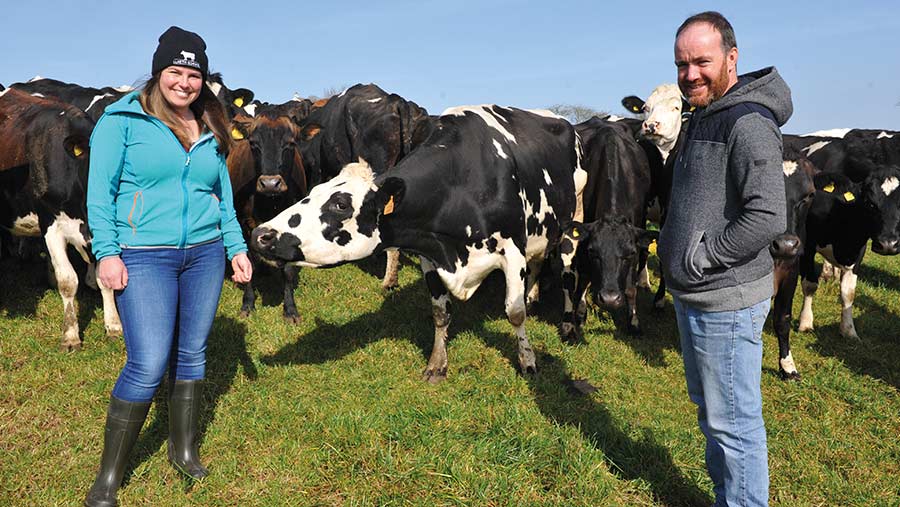Benefits of dual-purpose breed in three-way dairy cross
 © Debbie James
© Debbie James Introducing a dual-purpose breed into a cross-breeding programme on a Welsh dairy farm has added strength and size to its autumn calving herd.
The Fleckvieh strikes a balance between a grazing animal and one capable of eating large volumes of silage at housing, according to Deian Evans and Jamie McCoy, who farm near Newcastle Emlyn, with Deian’s father, Lyn.
The family brought Fleckvieh genetics into the herd in 2015, after switching from a year-round calving system with Holstein cows to autumn block-calving and increasing cow numbers from 80 to 185.
See also: 4 ways to further improve herd fertility
They opted for an autumn block system instead of spring calving because of the limited scope for grazing at Gorwel Farm – the grazing platform covers 34ha (84 acres).
“We couldn’t milk more cows on the grazing platform, but we have plenty of rented ground for making silage,” Mr Evans explains.
Jersey genetics were used initially to produce a herd that would be better suited to grass. “The large cow isn’t really suited to forage,” says Mr Evans.
Farm facts
- 162ha (400 acres) owned and rented land
- Three or four cuts of silage made annually
- Shallow, medium loam soil on solid rock
- Concentrate input 1.6t a cow a year
- 18% herd empty rate
- 12/24 Fullwood parlour
But crossing to a Jersey had too significant an impact on cow size, reducing the yield potential from the autumn milk system, he recalls. “What we ended up with were small Holsteins.”
So they decided to introduce a third cross. They looked at a range of breeds to find the one with the traits that would best complement their own herd and system, and the improvements they were hoping to make.
“What we were aiming for was to add a bit more power, to produce a robust animal,” says Mr Evans.
“We wanted a cow that would be profitable on our system. It wasn’t about breed or colour, it was about performance.”
Three-way cross
The Fleckvieh, a breed similar to a Simmental but one that has been selected for milk, offered these traits, so the business imported 15 in-calf and freshly calved heifers from Germany in 2015.
From a Holstein-based herd, the farm embarked on a three-way cross-breeding programme, using a Friesian, a Fleckvieh and a Norwegian Red. There are now about 50 Fleckvieh-cross cows in the herd.
The intention was to produce a functional cow, and crossing with a Fleckvieh has done that, says Mr Evans.

© Debbie James
Ms McCoy describes the Fleckvieh as “a really steady cow”. “They do things in their own time, and they are sensible ones in the herd – if ever a cow gets stuck anywhere, it is never a Fleckvieh.”
Heifers are all served to a Jersey for ease of calving, so the herd still has a strong Jersey influence, but cow size has increased to an average of 550kg.
Milk from forage
The Fleckvieh is a good match for a system that places emphasis on maximising milk from forage.
“The Fleckviehs are excellent forage converters, and as an autumn calving herd we need the cows to eat lots of silage, to eat to capacity,” says Ms McCoy.
What really sets the Fleckvieh-cross apart from others in the herd is that they thrive and never lose body condition, she adds.
“They never fail to carry good condition. They don’t go thin or fat: they are fit, meaty cows.”
Milk butterfat and protein have steadily improved, to an average of 4.9% butterfat and 3.6% protein.
Annual average milk yield is 6,700 litres. While the business is not producing quite as much milk as it was when it was milking a black-and-white herd, the milk is more saleable. The farm has a constituents-based contract with Glanbia.
Another characteristic of the Fleckvieh is its longevity. “Good longevity makes a cow more profitable because there is a lot of expense in replacing cows,” says Mr Evans.
Sexed semen has been used for the past four years, and the response has been so good that for the 2022 calving season the entire herd has been served to British Blue and Aberdeen Angus sires.
Calf values
Calf and cull values also benefit from the Fleckvieh influence. The calf price is comparable to that of a Limousin-cross, says Ms McCoy.
“There is a cost to rearing a beef calf – the cost of the eartags, feed, bedding and our time – so we need to get as much back from them as we possibly can. Calves are an output of the farm.”
Cull weights of Fleckvieh cross-breds are averaging 380kg deadweight – heavier than others in the herd.
Fleckvieh facts
- Fleckvieh is the second largest cattle breed in the world
- Balanced, productive dual-purpose animal that is suitable for milk and beef production
- Can be kept in all types of system
- Developed as an independent breed in 1920. The breeding aims were focused on a “middle of the road-type animal” with excellent muscling and good milk production
Artificial insemination starts in the first week of November, with cows housed on 1 November. Spring turnout is weather- and grass-dependent.
Some years it happens at the beginning of March, in others, a month later. This year the herd was out at grass by day on 24 February and fully grazing on 20 March.
The herd calves in a 12-week block from the beginning of September, with the aim of calving as many cows as possible outside.

Jamie McCoy and Deian Evans © Debbie James
Evaluating performance
As with everything else in the business, breeding and cow breed are constantly evaluated.
“Cows need to be reliable and to do the job, to integrate well within the herd. Those are our priorities, not necessarily what the breed is or what it looks like,” says Ms McCoy.
“We manage the herd as one – the cows here have to be quite robust; they don’t get individual treatment.”
Despite its many attributes, the business has no plans to increase the number of Fleckvieh crosses in the herd.
“A little bit of Fleckvieh genetic influence is good for all sorts of reasons but not too much because the cows become too beefy,” says Mr Evans.
